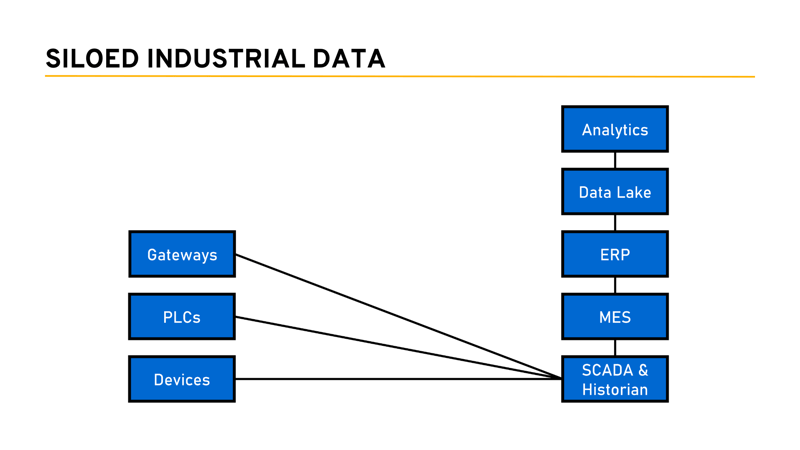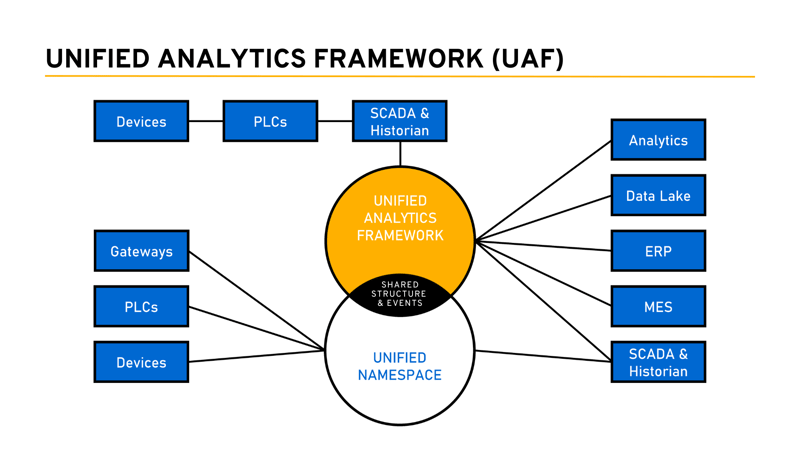Unified Analytics Frameworks (UAF) are here to revolutionize the way you store, process, and consume data. Picture a world where your data seamlessly flows together, enabling you to make informed decisions, optimize operations, and enhance collaboration across your organization. In this blog post, we'll break down what a UAF is and unveil three remarkable benefits of adopting this game-changing approach.
What is a Unified Analytics Framework?
A Unified Analytics Framework (UAF) is a comprehensive and integrated system that not only unifies all your data sources but also provides a complete solution for the entire data analytics lifecycle. It acts as a central hub that unifies data ingestion, processing, storage, access, contextualization, analysis, and visualization. In short, UAF can make all your dreams of predictive and prescriptive analytics a reality.
UAF works hand-in-hand with Unified Namespaces (UNS) to create a centralized hub for all of your industrial data. Think of the UAF like a central library and UNS like the Dewey Decimal system. A library can house all kinds of media, from all over the world, on a vast number of topics, in many different languages. Yet anyone can visit a library to find the exact information they need quickly and easily.
Now imagine a library made just for your company comprising all of your enterprise’s industrial data.
That’s the power of the UAF.



Benefits of a Unified Analytics Framework
So, what could a UAF do for you? Let's take a closer look at just three of the ways UAF can take your business to the next level.
Trustworthy, Enterprise-Wide Data
Data silos – the archenemy of data analysts and engineers everywhere. They cause fragmentation, duplication, and worse, inconsistencies in your data.
Data silos occur when departments each use their own distinct data systems. Say your company is a global food and beverage manufacturer. You could have data coming from IoT sensors on the factory floor, inventory databases, CRM, ERP, and more. Each of these data streams can use their own format and structures, making cross-functional data collaboration a nightmare.
UAF comes to the rescue by eliminating these data silos. With a UAF, these diverse data sources are seamlessly integrated and organized, facilitating a comprehensive view across your entire enterprise. You can effortlessly combine data from various sources – from sensors on the factory floor to sales reports. UAF can even support analytics across multiple UNSs, a common issue among multi-site global enterprises.
With UAF, your data is consistent and trustworthy, helping you make decisions that boost efficiency, reduce costs, and increase profitability.
UAF is your data superhero, ensuring data integrity reigns supreme.

Scalability and Adaptability
Technology evolves at lightning speed. The struggle to stay relevant in a rapidly changing industrial landscape is real. What’s more, as your business evolves and grows, so does its volume of data and data sources.
With all these opportunities for change, your business needs a structured way to seamlessly accommodate more data and data sources without compromising performance. You need a way to rapidly incorporate tailored solutions for challenges and objectives specific to your industry and company.
UAF gives you a structure that evolves and grows with you to ingest, process, store, access, contextualize, analyze, and visualize your data. UAF's scalability and adaptability enable you to seamlessly incorporate new tools, techniques, and data sources into your existing framework.
UAF ensures that you're always prepared to embrace the latest technology, no matter where the industry takes you.
Predictive & Prescriptive Analytics
One of the most exciting benefits of a UAF is its capacity to lay the foundation for advanced analytics—specifically, predictive and prescriptive analytics. By aggregating historical and real-time data across your enterprise, a UAF facilitates the creation of sophisticated models that predict future outcomes or prescribe actions based on existing data patterns.
Imagine a scenario where you’re an energy production company using a UAF to combine historical energy consumption data, weather patterns, and operational data. With this integrated dataset, you can build predictive models that forecast energy demands based on weather forecasts. Furthermore, you could use prescriptive analytics to recommend optimal adjustments to your energy production schedules, maximizing efficiency and cost-effectiveness.
While we’ve only listed three benefits, the potential UAFs hold for your business is boundless. UAF creates a world where your data works seamlessly for you, providing insights that lead to better decisions and greater efficiency.
To delve deeper into this revolutionary solution, we invite you to download our comprehensive white paper. We’ll show you real-world examples and guide you through the implementation processes for UNS and UAF. Click the link below to access the white paper and begin your journey of data-driven success.

8920.png)


COMMENTS